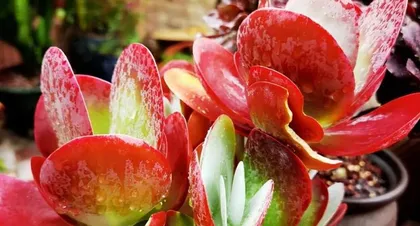Succulent plants have become increasingly popular in recent years due to their unique shapes and colors. Among them, Cotyledon orbiculata is the most sought-after, not only for its beautiful shape but also for its vibrant colors. If you also want to add this beautiful succulent to your garden, please continue reading the following.

Understanding the Growing Environment of Cotyledon orbiculata
Cotyledon orbiculata is native to tropical regions of Africa and has certain requirements for temperature and humidity. It grows well in the southern regions of China. To help it grow better, we need to create an environment suitable for it.
Choosing the Right Planting Container
You can choose various pots for planting Cotyledon orbiculata, but it is best not to use containers that are too deep or too shallow. At the same time, pay attention to using well-draining soil and avoiding excessive humidity during cultivation.

Watering and Care for Cotyledon orbiculata
Cotyledon orbiculata should be watered sparingly, usually once every 5-7 days, which can be adjusted according to different seasons and climatic conditions. Also, be careful not to water the leaves directly to avoid water spots and rot.
Understanding the Sunlight Requirements of Cotyledon orbiculata
Cotyledon orbiculata has certain requirements for sunlight, typically needing 4-6 hours of direct sunlight. However, during the hot summer months, be sure to avoid direct sunlight to prevent leaf scorch.
Proper Fertilization
Appropriate fertilization can increase the plant's nutrient supply, enhance its resistance, and promote growth. However, Cotyledon orbiculata does not require excessive fertilization; generally, once every two months is sufficient.

Removing Withered Leaves in a Timely Manner
Cotyledon orbiculata grows quickly and is prone to producing withered leaves. These withered leaves can affect the plant's aesthetics and health and should be removed promptly.
Pest Control
Cotyledon orbiculata can also be threatened by pests, mainly aphids and whiteflies. When pests are found, you can use appropriate insecticides or manually remove them.
Regular Pruning
Cotyledon orbiculata grows quickly and can easily become too lush without pruning. Regular pruning can maintain the plant's beautiful shape, increase air circulation, and prevent disease.
Avoid Excessive Moving
Cotyledon orbiculata is sensitive to environmental changes, and frequent moving can easily lead to abnormal growth. After planting, it should be moved as little as possible.
Avoiding Stormy Weather
Cotyledon orbiculata prefers a warm and dry environment and can be easily damaged by waterlogging during heavy rainstorms. In such cases, the plant should be moved to a sheltered place to avoid waterlogging.
Seasonal Adjustments
Different adjustments are needed in different seasons. For example, in the summer, direct sunlight should be avoided, while in the winter, the duration of sunlight should be increased to help Cotyledon orbiculata grow better.
Controlling the Indoor Environment
When growing Cotyledon orbiculata indoors, it is important to control the ambient temperature and humidity. Avoid placing it in places that are too humid or too dry.
Observing the Growth of Cotyledon orbiculata
When growing Cotyledon orbiculata, it is necessary to frequently observe its growth condition, including the color and state of the leaves, dryness, and pest infestations. Timely detection and treatment of problems can help Cotyledon orbiculata grow better.
Aesthetic Value of Cotyledon orbiculata
Due to its beautiful shape, vibrant colors, and varied forms, Cotyledon orbiculata is widely used in gardening and potted plants. At the same time, exquisite succulent bonsai can be created by combining plants with elements such as stones.
Key Care Points for Cotyledon orbiculata
Through the above introduction, I believe everyone now understands how to care for Cotyledon orbiculata. To summarize briefly, Cotyledon orbiculata requires proper watering, fertilization, and regular pruning, attention to pest control and environmental temperature and humidity, and seasonal adjustments. In this way, we can cultivate a beautiful Cotyledon orbiculata at home.